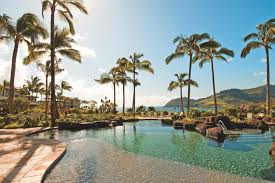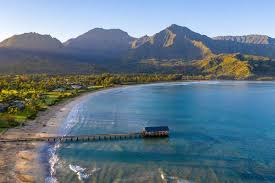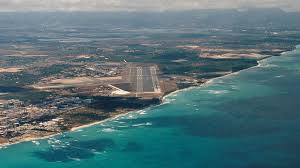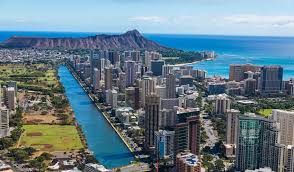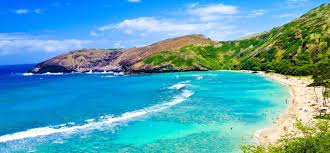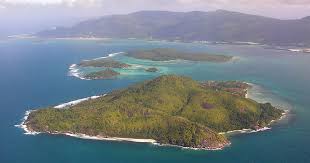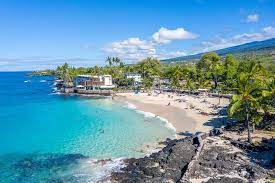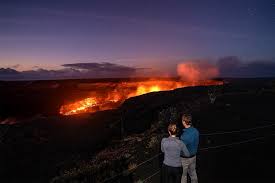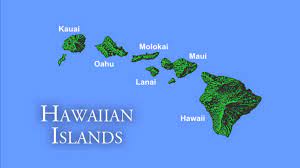
The Hawaiian Islands: A Paradise Like No Other
Nestled in the vast expanse of the Pacific Ocean lies a tropical paradise that captivates the hearts and souls of all who visit – the Hawaiian Islands. Renowned for their stunning natural beauty, vibrant culture, and warm hospitality, these islands offer an experience unlike any other.
Comprised of eight main islands, each with its own distinct character and allure, Hawaii is a dream destination for travelers seeking adventure, relaxation, and a deep connection with nature. From the bustling streets of Honolulu on Oahu to the laid-back vibes of Maui and the untamed wilderness of Kauai, there is something for everyone in this enchanting archipelago.
One cannot talk about Hawaii without mentioning its breathtaking landscapes. Picture-perfect beaches with powdery white sand and crystal-clear turquoise waters are abundant here. Whether you’re looking to catch some waves on world-famous surf breaks or simply lounge under swaying palm trees while sipping a refreshing drink, Hawaii’s beaches are truly idyllic.
But it’s not just about the beaches – Hawaii boasts an incredible variety of natural wonders. Explore lush rainforests teeming with exotic flora and fauna on hikes through verdant valleys. Witness dramatic waterfalls cascading down sheer cliffs or take a scenic drive along breathtaking coastal roads that offer panoramic views at every turn. And let’s not forget about the majestic volcanoes that shape these islands – visit Hawaii Volcanoes National Park on the Big Island to witness firsthand the raw power of Mother Nature.
Beyond its natural beauty, Hawaii is also steeped in rich cultural heritage. The native Hawaiian people have a deep connection with their land and traditions that are still celebrated today. Immerse yourself in Polynesian history by attending a traditional luau where you can witness captivating hula performances and indulge in delicious local cuisine like kalua pork and poi. Learn about ancient Hawaiian customs and legends at museums and cultural centers, or visit sacred sites that hold spiritual significance to the indigenous population.
Hospitality is a way of life in Hawaii, and the warmth and friendliness of the locals will make you feel right at home. Embrace the “aloha spirit” – a concept that encompasses love, peace, and compassion – as you interact with the people who call these islands home. Engage in conversations, listen to their stories, and gain a deeper understanding of the Hawaiian way of life.
Whether you’re seeking adventure or relaxation, cultural immersion or natural beauty, the Hawaiian Islands offer an experience that will leave an indelible mark on your soul. From sunrise hikes to witnessing mesmerizing sunsets over the Pacific Ocean, every moment spent in Hawaii is a treasure to be cherished. So pack your bags, leave your worries behind, and embark on a journey to this paradise like no other – the Hawaiian Islands await your arrival.
8 Essential Tips for Exploring the Hawaiian Islands
- Pack light – Hawaii has a tropical climate, so you won’t need to bring much clothing.
- Bring sunscreen and a hat – the sun is strong in Hawaii and can burn your skin quickly.
- Take advantage of the outdoors – explore Hawaii’s beautiful beaches, mountains, waterfalls, and trails.
- Try local food – Hawaiian cuisine includes dishes like poi (mashed taro root), lomi-lomi salmon (salmon with tomatoes), and poke (raw fish salad).
- Respect the environment – be mindful of your impact on nature while exploring Hawaii’s natural wonders.
- Learn about Hawaiian culture – visit museums or take part in cultural activities to learn more about this unique island state’s history and traditions.
- Don’t forget to relax – make sure to take some time out during your trip for rest and relaxation!
- Make new friends – locals are usually friendly and welcoming; strike up conversations with them to get a better understanding of their culture!
Pack light – Hawaii has a tropical climate, so you won’t need to bring much clothing.
Pack Light and Embrace the Island Life in Hawaii
When it comes to packing for a trip to the Hawaiian Islands, there’s one golden rule to keep in mind – pack light! With its tropical climate and laid-back atmosphere, Hawaii offers the perfect opportunity to embrace a minimalist approach when it comes to your wardrobe.
Thanks to the year-round warm weather, you can leave those bulky sweaters and heavy coats behind. Instead, focus on lightweight and breathable clothing options that will keep you comfortable in the island’s balmy temperatures. Think airy sundresses, shorts, t-shirts, and lightweight pants or skirts. Don’t forget to pack a swimsuit or two – after all, Hawaii is famous for its stunning beaches!
Since you’ll likely spend most of your time outdoors exploring the islands’ natural wonders or lounging by the ocean, it’s essential to prioritize comfort and versatility when choosing your outfits. Opt for fabrics that are moisture-wicking and quick-drying so you can easily transition from a hike through lush rainforests to a dip in the ocean without feeling weighed down.
Remember, Hawaii has a casual vibe, so leave your formal attire at home. Embrace the island lifestyle by packing functional footwear like sandals or comfortable walking shoes for all your adventures. And don’t forget essentials like a wide-brimmed hat, sunglasses, sunscreen, and insect repellent to protect yourself from the elements.
By packing light, not only will you save space in your luggage but you’ll also have more freedom to explore without being weighed down by unnecessary items. Plus, with plenty of shopping opportunities throughout Hawaii’s vibrant towns and markets, you can always pick up any additional clothing or accessories you may need during your stay.
So as you prepare for your Hawaiian getaway, remember this simple tip – pack light! Embrace the tropical climate and laid-back lifestyle of these beautiful islands by keeping your wardrobe simple yet practical. With minimal luggage in tow, you’ll be ready to fully immerse yourself in the breathtaking landscapes, vibrant culture, and warm hospitality that Hawaii has to offer. Aloha!
Bring sunscreen and a hat – the sun is strong in Hawaii and can burn your skin quickly.
Protect Your Skin in Paradise: Sunscreen and Hats for a Safe Hawaiian Adventure
When embarking on a journey to the beautiful Hawaiian Islands, it’s important to remember that the sun shines brightly in this tropical paradise. With its proximity to the equator, Hawaii experiences intense sunlight that can lead to sunburns if proper precautions are not taken. That’s why it’s essential to bring along sunscreen and a hat to protect your skin from harmful UV rays.
The Hawaiian sun may be inviting, but its strength should not be underestimated. The combination of clear skies, sparkling waters, and white sandy beaches creates an environment where the sun’s rays can be particularly harsh. Even on cloudy days, UV radiation can still reach your skin, so it’s crucial to be proactive in safeguarding yourself.
Before you head out for a day of exploration or relaxation under the Hawaiian sun, make sure you have a high-quality sunscreen with a broad spectrum SPF (Sun Protection Factor) of 30 or higher. Apply it generously and frequently throughout the day, especially after swimming or sweating. Don’t forget those easily overlooked areas like your ears, nose, and tops of your feet.
Additionally, wearing a hat is an excellent way to shield your face and scalp from direct sunlight. Opt for wide-brimmed hats that provide ample coverage for your face, neck, and ears. Not only will this help protect you from harmful rays but it will also keep you cool under the tropical heat.
By taking these simple yet essential steps to protect your skin from the strong Hawaiian sun, you can fully enjoy all that these islands have to offer without worrying about painful sunburns or long-term damage. Remember: prevention is key when it comes to keeping your skin healthy and safe.
So as you pack your bags for your dream vacation in Hawaii, don’t forget to prioritize sunscreen and hats as must-have items. Your skin will thank you as you bask in the beauty of this island paradise, knowing that you’ve taken the necessary precautions to enjoy your time under the sun responsibly.
Take advantage of the outdoors – explore Hawaii’s beautiful beaches, mountains, waterfalls, and trails.
Take Advantage of the Outdoors: Explore Hawaii’s Natural Wonders
When it comes to experiencing the true essence of Hawaii, there is no better way than immersing yourself in its breathtaking outdoors. With its stunning beaches, majestic mountains, cascading waterfalls, and scenic trails, the Hawaiian Islands offer a paradise for nature lovers and adventure seekers alike.
One of the most iconic features of Hawaii is its pristine beaches. From the famous Waikiki Beach in Honolulu to the secluded shores of Lanikai on Oahu, and from the golden sands of Ka’anapali in Maui to the rugged beauty of Papohaku Beach on Molokai, there is a beach for every preference. Take a dip in crystal-clear waters, soak up the sun on powdery white sand, or try your hand at various water activities such as snorkeling, surfing, or paddleboarding. The beaches of Hawaii are not just picturesque; they are an invitation to unwind and connect with nature.
For those seeking a more adventurous experience, Hawaii’s mountains offer incredible opportunities for exploration. Hike to the summit of dormant volcanoes like Haleakala on Maui or Mauna Kea on the Big Island for awe-inspiring panoramic views. Traverse lush rainforests on trails that lead to hidden waterfalls like Manoa Falls on Oahu or Waimoku Falls on Maui. The mountains of Hawaii are not just towering landmarks; they are gateways to discovering untouched beauty and serenity.
Speaking of waterfalls, Hawaii boasts some truly mesmerizing cascades that will leave you in awe. From the majestic Akaka Falls on the Big Island to the enchanting Waimea Falls on Oahu’s North Shore, these natural wonders are worth exploring. Take a refreshing swim beneath their cascading waters or simply marvel at their sheer beauty as you capture unforgettable memories.
Hawaii’s extensive network of trails offers an opportunity to immerse yourself in its diverse landscapes. Whether you’re a seasoned hiker or a casual walker, there are trails for every skill level. Explore the Napali Coast on Kauai, where rugged cliffs meet the sparkling ocean, or venture into the lush valleys of the Hana Highway on Maui. These trails not only provide physical exercise but also lead you to hidden gems and panoramic viewpoints that will take your breath away.
So, whether you’re a beach lover, a mountain enthusiast, a waterfall chaser, or an avid hiker, Hawaii’s natural wonders beckon you to explore and embrace the outdoors. Step outside and let the beauty of this tropical paradise captivate your senses. Take advantage of what Hawaii has to offer and create memories that will last a lifetime.
Try local food – Hawaiian cuisine includes dishes like poi (mashed taro root), lomi-lomi salmon (salmon with tomatoes), and poke (raw fish salad).
Indulge in the Flavors of Hawaii: Try Local Food
When exploring the Hawaiian Islands, one of the best ways to truly immerse yourself in the culture is through its vibrant and diverse cuisine. From traditional dishes passed down through generations to modern culinary creations, Hawaiian food offers a delightful journey for your taste buds.
One must-try element of Hawaiian cuisine is poi, a staple made from mashed taro root. Poi has been a dietary staple for Hawaiians for centuries, and its unique texture and mild flavor make it an intriguing addition to any meal. Give it a try and experience the taste of tradition.
Another local favorite is lomi-lomi salmon, a refreshing dish that combines diced salmon with tomatoes, onions, and sometimes even green onions. This colorful salad-like creation offers a burst of flavors that perfectly complement each other. Its tangy and savory profile makes it an excellent side dish or even a light meal on its own.
If you’re a seafood lover, you can’t miss out on poke – a beloved raw fish salad that has gained popularity worldwide. Typically made with fresh marinated fish like tuna or salmon, poke is seasoned with soy sauce, sesame oil, green onions, and other delicious ingredients for added depth of flavor. It’s served as an appetizer or main course and showcases the incredible freshness of Hawaiian seafood.
While these dishes represent just a glimpse into Hawaiian cuisine, they exemplify the fusion of flavors influenced by Polynesian traditions and multicultural influences from immigrants who have made Hawaii their home over the years.
Exploring local food not only satisfies your taste buds but also provides insight into the history and cultural diversity of Hawaii. So go ahead – venture beyond familiar dishes and embrace the opportunity to try something new during your island adventure. From traditional poi to mouthwatering lomi-lomi salmon and poke bursting with freshness, let your culinary exploration be an unforgettable part of your Hawaiian experience.
Respect the environment – be mindful of your impact on nature while exploring Hawaii’s natural wonders.
Respect the Environment: Preserving the Beauty of Hawaii’s Natural Wonders
When exploring the stunning natural wonders of Hawaii’s islands, it is crucial to remember the importance of respecting and preserving the environment. As visitors, we have a responsibility to be mindful of our impact on these fragile ecosystems.
Hawaii is blessed with an abundance of breathtaking landscapes, from lush rainforests and pristine beaches to volcanic wonders. It is our duty to ensure that future generations can also enjoy these treasures. Here are a few simple ways you can show respect for the environment while exploring Hawaii:
First and foremost, practice responsible tourism. Stick to designated trails when hiking and avoid stepping on delicate vegetation or disturbing wildlife habitats. Keep in mind that many areas are protected for a reason – to preserve their natural beauty and ecological balance.
Dispose of your waste properly. Hawaii has a fragile ecosystem, and littering can have severe consequences for both land and marine life. Always carry a bag with you to collect any trash you generate during your visit, and make sure to dispose of it in designated bins.
Be mindful of water usage. While enjoying Hawaii’s stunning beaches, remember that water is a precious resource on these islands. Conserve water whenever possible by taking shorter showers and turning off taps when not in use.
Respect marine life. When snorkeling or diving in Hawaii’s crystal-clear waters, admire marine creatures from a distance without touching or disturbing them. Avoid standing on coral reefs as they are delicate living organisms that take years to grow.
Support sustainable practices. Choose eco-friendly tour operators and accommodations that prioritize sustainability and conservation efforts. By supporting businesses committed to protecting the environment, you contribute to the preservation of Hawaii’s natural wonders.
Educate yourself about local regulations and guidelines regarding environmental conservation in Hawaii. Stay informed about any specific rules or restrictions related to protected areas, wildlife encounters, or responsible outdoor activities.
Remember, by respecting the environment during your visit to Hawaii, you not only help preserve the beauty of these islands but also contribute to the overall well-being of their ecosystems. Let us all play our part in ensuring that future generations can continue to enjoy the natural wonders that Hawaii has to offer.
Learn about Hawaiian culture – visit museums or take part in cultural activities to learn more about this unique island state’s history and traditions.
Immerse Yourself in Hawaiian Culture: Uncover the Rich History and Traditions of the Islands
When visiting the Hawaiian Islands, it’s not just about soaking up the sun and enjoying the natural beauty – it’s also an opportunity to delve into the captivating world of Hawaiian culture. By taking the time to learn about the history and traditions of this unique island state, you can gain a deeper appreciation for its people and their way of life.
One way to explore Hawaiian culture is by visiting museums dedicated to preserving and showcasing the islands’ rich heritage. These museums offer a wealth of knowledge through exhibits, artifacts, and interactive displays. From ancient Polynesian voyaging canoes to royal artifacts and contemporary artwork, these venues provide a window into Hawaii’s past and present.
The Bishop Museum in Honolulu is a must-visit for anyone interested in Hawaiian history. With its extensive collection of artifacts, including traditional crafts, royal regalia, and archaeological discoveries, this museum offers a comprehensive overview of Hawaii’s cultural roots. You can also learn about the islands’ natural history, geology, and marine life at their planetarium and science center.
Another way to immerse yourself in Hawaiian culture is by participating in cultural activities. Many resorts and tour operators offer opportunities to engage with local traditions such as hula dancing lessons or lei-making workshops. These hands-on experiences allow you to learn directly from skilled practitioners who are passionate about preserving their heritage.
Attending a traditional luau is another fantastic way to experience Hawaiian culture firsthand. These lively celebrations feature vibrant music, mesmerizing hula performances, and mouthwatering feasts that showcase local cuisine. As you savor delicious dishes like kalua pork cooked in an imu (underground oven) or taste poi made from taro root, you’ll gain insight into traditional food practices that have been passed down through generations.
Beyond museums and cultural activities, exploring sacred sites can also provide valuable insights into Hawaiian culture. Places like Pu’uhonua o Hōnaunau National Historical Park on the Big Island or the heiau (temples) scattered across various islands offer a glimpse into ancient Hawaiian spiritual practices and beliefs. These sites are not only historically significant but also hold a deep cultural reverence for the native Hawaiian people.
By taking the time to learn about Hawaiian culture, you can develop a deeper connection with the islands and its people. Through museums, cultural activities, and visits to sacred sites, you’ll gain a greater understanding of Hawaii’s history, traditions, and values. So make it a point to explore this vibrant aspect of the Hawaiian Islands during your visit – it will undoubtedly enrich your overall experience and leave you with lasting memories of this remarkable destination.
Don’t forget to relax – make sure to take some time out during your trip for rest and relaxation!
Don’t Forget to Relax: Unwind and Recharge on the Hawaiian Islands
When planning a trip to the beautiful Hawaiian Islands, it’s easy to get caught up in the excitement of exploring new sights, trying thrilling activities, and immersing yourself in the vibrant local culture. However, amidst all the adventure and discovery, it’s crucial not to overlook one essential tip: don’t forget to relax.
Hawaii is renowned for its laid-back atmosphere and tranquil surroundings, making it the perfect destination to unwind and recharge. With its stunning beaches, lush landscapes, and soothing ocean breezes, this paradise offers an abundance of opportunities for rest and relaxation.
Take some time out from your busy itinerary to simply lounge on the soft sands of a picturesque beach. Let the rhythmic sound of crashing waves lull you into a state of pure tranquility as you soak up the warm Hawaiian sun. Feel your worries melt away as you immerse yourself in the serenity of nature.
If you’re seeking a more active form of relaxation, consider indulging in activities that promote wellness and rejuvenation. Many resorts and spas offer luxurious treatments inspired by traditional Hawaiian healing practices. Treat yourself to a massage using fragrant local oils or participate in a yoga class overlooking breathtaking ocean vistas. These experiences will not only relax your body but also nourish your mind and soul.
For those who prefer a slower pace, take leisurely strolls through botanical gardens or visit one of Hawaii’s many peaceful parks. Breathe in the fresh tropical air while admiring vibrant flowers, towering palm trees, and cascading waterfalls. Connecting with nature has a profound way of restoring balance within us.
Additionally, don’t be afraid to embrace the “island time” mentality during your stay. Allow yourself moments of stillness to fully appreciate the beauty around you – watch mesmerizing sunsets paint the sky with hues of orange and pink or gaze at a star-studded night sky that seems to stretch infinitely.
Remember, a well-rested traveler is a happy traveler. By incorporating relaxation into your Hawaiian adventure, you will return home feeling rejuvenated and energized. So, as you embark on your journey to the Hawaiian Islands, make sure to carve out some time for rest and relaxation. Your mind, body, and spirit will thank you for it.
Make new friends – locals are usually friendly and welcoming; strike up conversations with them to get a better understanding of their culture!
Make New Friends on the Hawaiian Islands: Embrace the Aloha Spirit!
When visiting the Hawaiian Islands, one of the most rewarding experiences you can have is connecting with the locals. Known for their warm hospitality and friendly nature, Hawaiians are often eager to share their culture and traditions with visitors. So, don’t hesitate to strike up conversations and make new friends during your stay!
The key to unlocking a deeper understanding of Hawaiian culture lies in engaging with the local community. Whether you’re exploring bustling cities or remote villages, take the opportunity to connect with people you encounter along the way. You’ll be pleasantly surprised by their genuine interest in sharing their knowledge and stories.
One of the best ways to start a conversation is by showing respect for local customs and traditions. Learn a few basic phrases in Hawaiian, such as “Aloha” (hello/goodbye) or “Mahalo” (thank you), as it demonstrates your interest in their language and culture. Locals appreciate when visitors make an effort to embrace their way of life.
As you strike up conversations, be open-minded and curious about their experiences. Ask questions about local traditions, history, or even recommendations for hidden gems off the beaten path. Hawaiians take pride in their heritage and are often delighted to share insights that may not be found in guidebooks.
Don’t be surprised if you find yourself invited to join a beach gathering, a community event, or even a traditional feast known as a “luau.” Embrace these opportunities with an open heart and immerse yourself in the festivities. These interactions will provide a more authentic experience of Hawaii’s vibrant culture.
By making new friends among the locals, you’ll gain a unique perspective on life in Hawaii that goes beyond what tourist attractions can offer. You’ll learn about ancient legends passed down through generations, discover secret spots only known by locals, and perhaps even develop long-lasting friendships that extend far beyond your visit.
So, during your time on the Hawaiian Islands, remember to embrace the aloha spirit and make an effort to connect with the locals. Their warmth and welcoming nature will enrich your journey and leave you with memories that will last a lifetime.
